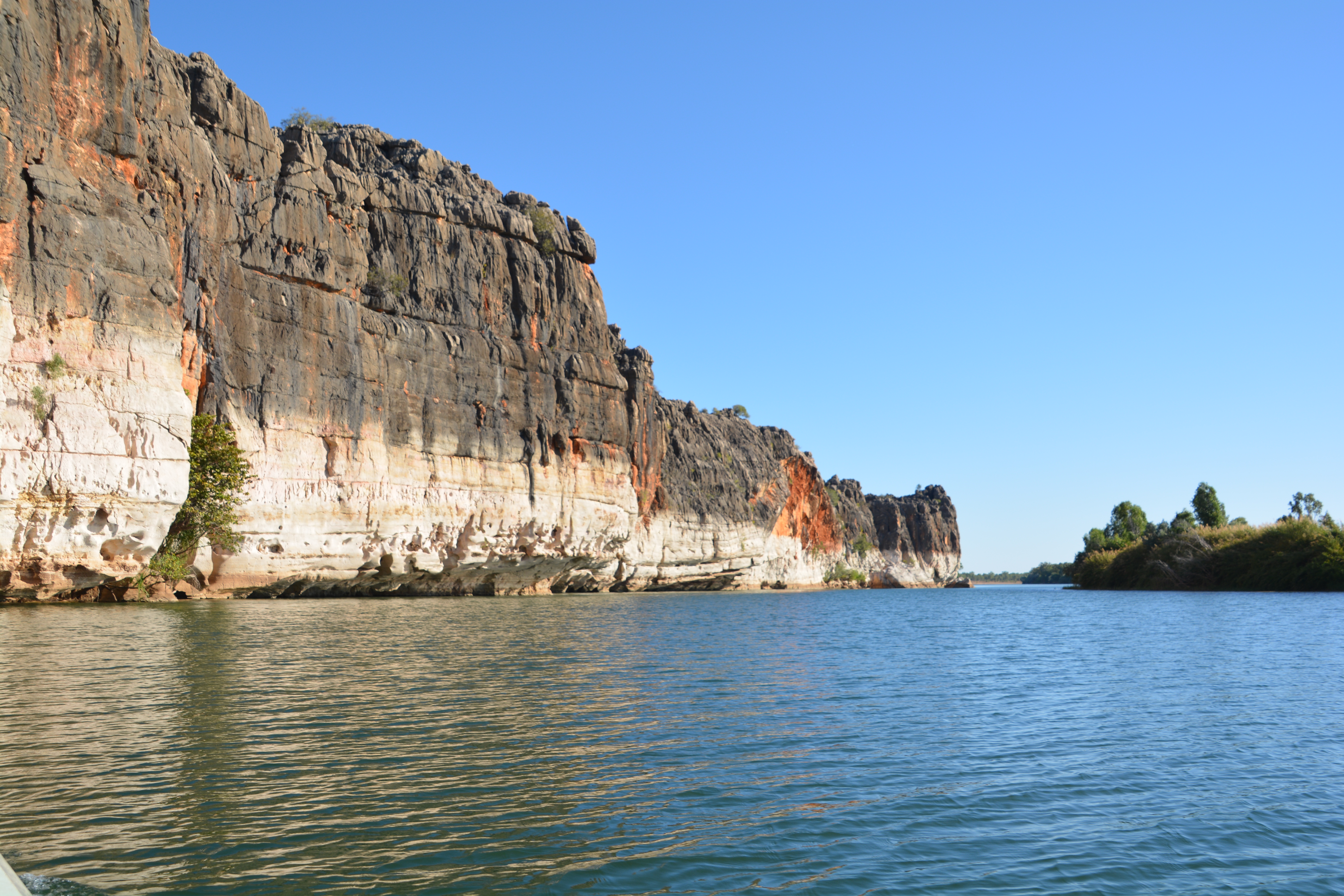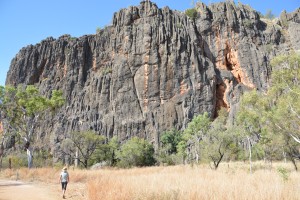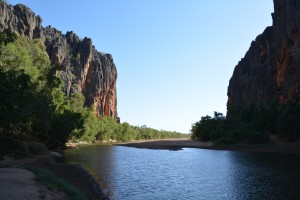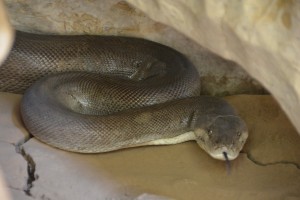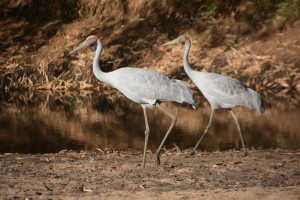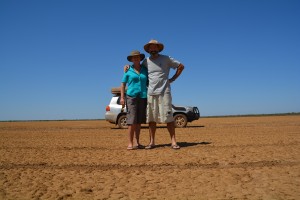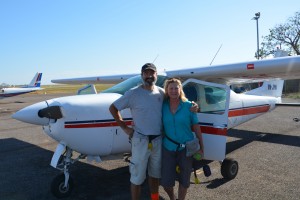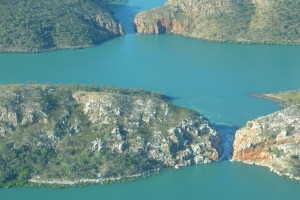Devonian reefs and birthday treats
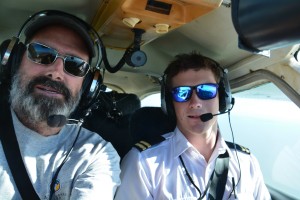
The birthday boy and our pilot on our spectacular sightseeing flight over the beautifully named Bucaneer Archipelago
It’s hard to get your mind around the fact that the rugged rocky mountain range in front of you was at one time on the bottom of the ocean floor. Even more so, it made up a huge reef system which ancient underwater creatures called home. And yet here we are, in dusty fly-infested 35 degree desert heat seeing these grandly sculptured mountain cliffs, twisted shapes and crustacean fossils in what is now called the Devonian Reefs. We were walking back in time, 360 million years ago to be exact!
This mountain range, which is now called the Napier Ranges, runs southwest of the Gibb River Road before the road terminates in Derby. The Devonian Reef Conservation Area consists of three national parks that are all linked because of their origins as part of the ocean floor. We spent three days in the area and gained a new appreciation for the power of earth, water and the passage of time.
First stop was Windjana Gorge National Park, a deep and long cut through the range that provided keen walkers with a chance to walk seven kms up and back down the canyon and get a glimpse of what life was like all those eons ago. For us it was also an extension of the zoo theme that had started some days ago in Bell Gorge due to seeing many animals during our walk up the gorge.
Freshwater crocodiles live year round in this canyon, thriving in the deep waterholes that are full of fish, and they sit on the sandy banks of the water sunning themselves quietly unless you get too close. At another turn we saw a huge Olive Python, curled up in a little rock shelter, both parties keeping a safe distance. These non-venomous snakes are said to get up to 6.5 metres in length, making it a true monster of Australian snakes.
As we walked up the sandy canyon, vertical rock cliffs following us on both sides, no one within cooee, we admired a pair of brolgas feeding in the shallow water pools and the hundreds of fruit bats – flying foxes as they’re called – making a huge racket (and smell) as they hang upside down in trees shadowing the trail. And of course there is always the nearby wallaby suddenly jumping out of the bushes as we get close, scaring the hell out of us.
The next day we ventured up the road to Tunnel Creek National Park, surely one of the smallest national parks anywhere. Tunnel Creek is exactly as it sounds, a creek that flows through a long twisting tunnel under the Napier Range. We took our torches and wore our water shoes before venturing into this dark cavern. The tunnel is 750 metres long with a few turns in it making the middle section completely dark. It also had a number of water crossings in it where we had to wade through the water above our knees, torch firmly squeezed in our hands. And finally, as we expected, we saw the eyes of freshwater crocs gleaming in our torches, silently lurking near the edges of the pools as we walked through them in the dark.
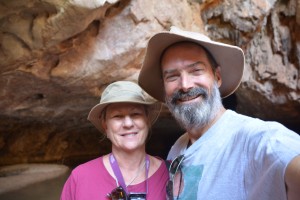
We saw crocs in the water we were wading through in Tunnel Creek but were able to smile about it later
Tunnel Creek was an amazing geologic phenomenon and a totally unexpected little adventure for us. That we were in there by ourselves with only our torches and confidence that dozens of people do it each day did we continue on. Very cool.
We drove a bit further to link up with the Great Northern Highway and drove the short distance on bitumen – our first major bit of paved road in two weeks – to the small town of Fitzroy Crossing. The town is as the town sounds, the first and still main crossing of the mighty Fitzroy River, today home to only about 1,000 people, most of whom are Aborigines, and very sleepy.
We did a delightful boat cruise on the Fitzroy River through Geike Gorge which makes up the main feature of the local national park by the same name. This gorge, different from others, was very wide and you could appreciate the mighty power of this great river when it is at full force in the wet season. They say the Fitzroy River at the height of the wet season has the second highest output in the world behind the Amazon, at some stages on the lower plains having a width of over 25 kms. It was great fun to see the dramatic results of this great river up close from a boat and appreciate – again – the amazing forces that play out each season in this region.
Our final night before hitting civilisation was a magic night in a private little bush camp in the middle of the 360 million year old Devonian Reef, the stars all above us, the fire sparkling against the nearby rocks. It was a fitting end to this section of our journey.
The next day we drove into the small coastal town of Derby, famous for its mud flats and amazing 11 metre tides. Our arrival in Derby marked three key events – first, the end of our fantastic journey down the Gibb River Road which started almost three weeks ago in Wyndham; second, our opportunity to vote in the federal election (with all the locals, very interesting in itself); and third, to celebrate my birthday.
To celebrate an event that needs no celebration we took a scenic flight in a small four seater single engine plane over the beautiful coastline north of Derby. This small plane which carried only the two of us and our (very) young pilot flew over the beautiful patterns of the long reaching mud flats near Derby which are caused by the exceptional tides in this area. We then flew over and around what are known as the horizontal falls which is basically tidal water flowing through two large cracks in a fractured coastline. The effect of this water rushing through these narrow openings is almost a waterfall – or horizontal falls – which make for quite a scene.
We then flew over the Buccaneer Archipelago (two words which are great fun to say together), a part of the coastline with over 1000 islands, including two adult whales with a tiny baby and two large islands being mined for high quality iron ore 60 metres below sea level. The views from the plane as we flew at less than 2,000 feet were absolutely stunning and it was great fun to see all these tiny islands with their shapes and features and rocks and beaches from a unique angle. A great birthday gift, for sure.
